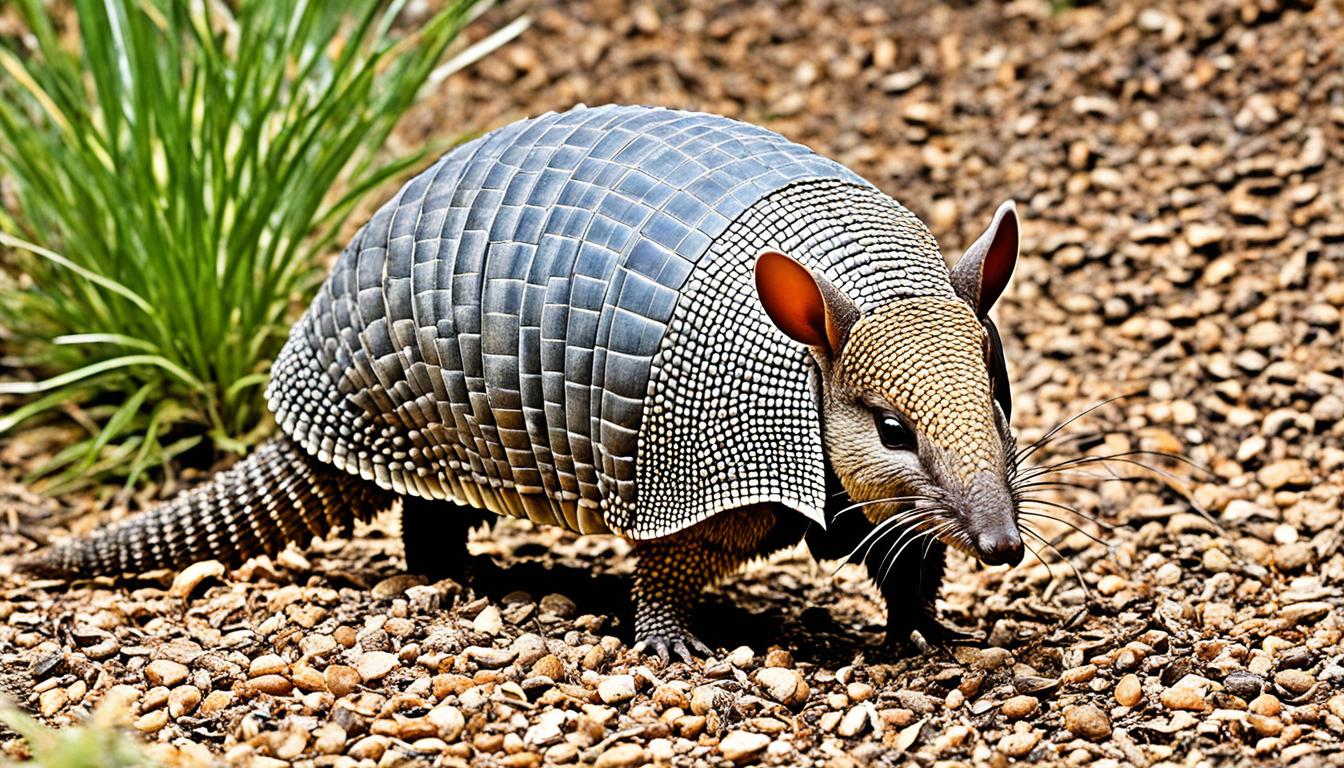Armadillos, especially the nine-banded ones in the U.S., like specific places to live. They love temperate and moist spots. This means they enjoy places like dense brushes, woodlands, and grasslands. These spots have soft, porous soil, which is great for their digging habits.
With their powerful claws, armadillos can easily dig up the ground. They make burrows in these areas to find food and stay safe. So, it’s no surprise they pick places full of soil with lots of bugs.
Introduction to Armadillo Habitat Preferences
The armadillo needs special places to live that are critical to its wellbeing. In the U.S., the nine-banded armadillo stands out for choosing certain areas for living. These places are good for digging holes and finding food easily.
Why Habitat is Important for Armadillos
Knowing about the armadillo’s home is very important. They need loose, sandy dirt to dig easily. This dirt helps them get to their food easily too. They like areas with lots of plants to hide and warm weather.
Overview of Armadillo Species in the U.S.
In the U.S., the most common armadillo is the nine-banded armadillo. You mostly find them in places like Texas and along the Gulf Coast to Missouri. They do well in these spots because the environment suits them. They are good at adapting and having babies, which helps them spread to new areas.
| Habitat Type | Characteristics |
|---|---|
| Loose, Sandy Soils | Ideal for digging and finding food |
| Dense Vegetation | Provides cover and protection from predators |
| Warm Climates | Facilitates survival and reproduction |
Forested Areas: A Common Armadillo Habitat
Armadillos love living in forests. These places offer cover and lots of food. They especially like areas with lots of dense plants, like woodlands, and both deciduous and pine forests.
Dense Brush and Woodlands
In dense brush and woodlands, armadillos get plenty of coverage. This makes it great for burrowing. The thick plants help them hide from enemies. Also, the soil is soft, which is perfect for their digging needs.
Pine and Deciduous Forests
Pine and deciduous forests are also top picks for armadillos. They offer a lot of shelter and are full of bugs, a big part of their diet. Armadillos choose these places because they can easily make burrows and find food.
Summarizing What Types of Habitats Do Armadillos Prefer?
Armadillos are great at finding just the right place to live. They like areas with lots of food, like bugs and worms. These types of food are important for them to eat. They also look for soils that are easy to dig into. This helps them make their homes underground, which is good for finding food and staying safe.
Armadillos also need places where they can hide from other animals. They find this safety in thick plants, woods, and big fields. It’s interesting that they can live around people too, if they get what they need. This means they do well in the wild or in places that have been changed by people, like cities. They are pretty good at living in different kinds of places.
| Habitat Type | Food Source | Soil Type | Cover Availability | Example Locations |
|---|---|---|---|---|
| Forested Areas | Abundant invertebrates | Loose, porous | Dense vegetation | Pine and Deciduous Forests |
| Grasslands | Insects and small invertebrates | Loamy soil | Moderate vegetation | Prairies, Meadows |
| Suburban Areas | Mixed diet, often including human leftovers | Varied, includes landscaped soil | Human structures, parks | Urban Parks, Backyards |
Grasslands and Open Areas
Armadillos aren’t just limited to forests. They also make their homes in grasslands and open spaces. Here, they can easily search for food and show off their interesting traits.

Types of Grasslands Armadillos Inhabit
In the U.S., armadillos find homes in a wide range of grasslands. From the tallgrass prairies in the Midwest to the Coastal Plains, there’s a place for them. These areas have the right kind of soil and enough hiding spots for armadillos.
Behavior and Diet in Grassland Environments
Armadillos use their sharp claws and a flexible tongue to find food. They eat invertebrates most of the time, digging up small bugs. Sometimes, they add plant food to their meals, making sure they get all the nutrients they need.
| Behavior | Diet | Preferred Soil |
|---|---|---|
| Foraging by digging | Invertebrates | Soft, porous soil |
| Using flexible tongue | Plant matter (occasionally) | Loamy to sandy |
Role of Soil in Armadillo Habitat Selection
Armadillos pick their homes based on the soil type where they live. They like places with soil that’s just right. To know more about armadillo habitat preferences, we look at how different soils change where they can live.
Preference for Loose, Sandy Soils
Armadillo habitat preferences show they love loose, sandy soils. These places are great because they are soft. Armadillos find it easy to make homes here and there’s plenty to eat. These spots also keep them safe from other animals.
Clay Soils as Alternative Habitats
Most armadillos like sandy places, but some are okay with clay. This shows how adaptable they are. Even though clay is harder, it still works well for things they need like a safe home and food. So, clay can be another good place for armadillos to live.
Armadillos in Urban and Suburban Areas
Armadillos are moving into cities and towns more. They are finding places within our habitats that feel like their homes. This is helping them to keep living and growing in number.
Interactions with Human Habitats
In urban areas, armadillos like places with lots of green. Places like parks, golf courses, and cemeteries. They use these areas to create homes by digging underground. This digging can leave marks like shallow holes or messy soil, showing they are looking for food.
Common Urban Habitats
In places near cities, armadillos find spots that remind them of where they come from. They love places like golf courses that are open and have plants, much like their natural homes. Cemeteries and parks are also great for them. They find food and make homes there, mixing well with the areas we live in.
Armadillos’ Adaptation to Unique Habitats
Armadillos are masters at adapting, which lets them live in many unique places. Their choice of where to live shows how clever and tough they are. This is important for surviving in different places.
Salt Marshes and Coastal Regions
Armadillos living in salt marshes and coastal areas prove how versatile they are. These places have salty water and soft ground, making them unusual for armadillos. Still, armadillos can find food and create homes there. This shows their amazing ability to adapt to different environments.
Burrowing in Golf Courses and Cemeteries
In cities, armadillos have found a home in golf courses and cemeteries by digging burrows. The soil there is soft and the area is quiet, which suits their digging needs. Such behavior shows that armadillos can live in unexpected places by making them work for their needs.
Armadillos’ adaptability is key to their survival around the world. Whether it’s in salt marshes or city golf courses, they show incredible flexibility and strength.
Climatic Preferences of Armadillos
Armadillos love warm, wet areas because they find a lot of food there. Their main food is invertebrates. So, these conditions lead to more armadillos and healthier ones.
Impact of Warm, Moist Climates
Armadillos, especially the nine-banded type, move where it’s warm and moist. This weather lets them find enough food. It also makes it easy for them to dig and have babies.
This helps their numbers grow, especially in the southern United States.
Survival in Mild Winter Regions
It is cool that armadillos change their daily habits to cope with mild winters. They are most active during the day when it’s warmer. This way, they stay warm in cold weather.
Thanks to this change, they can live in places with less harsh winters. This shows how adaptable the nine-banded armadillo is in different climates.
FAQ
What types of habitats do armadillos prefer?
Armadillos love temperate and moist places. They include dense brush, woodlands, and grasslands. These places have good soil for digging, food, and cover.
Why is habitat important for armadillos?
Habitats are crucial for armadillos. They require good soil for digging homes and plenty of food. Loose, sandy soils and dense plants are best for their survival.
Where in the U.S. can armadillos be found?
Their main home is in Texas and the Gulf Coast states. They’ve been found as far north as Missouri too. Their ability to adapt and breed fast spreads their living areas.
What types of forested areas do armadillos prefer?
Armadillos like dense brush and woodlands. This includes pine and deciduous forests. These places offer lots of food and materials for their burrows.
Do armadillos live in grasslands?
Yes, armadillos live in various grasslands. This is where they find invertebrates, their main food. They make shallow holes to get to insects and sometimes eat plants too.
What role does soil play in an armadillo’s habitat selection?
Soil is very important for armadillos. They look for loose, sandy soil full of food for digging burrows. But they can also live in clay soil if it meets their needs for burrowing and finding food.
How do armadillos interact with urban and suburban areas?
In cities, armadillos dig burrows in places like parks, golf courses, and cemeteries. These sites have what they need to survive near people.
Can armadillos adapt to unique or unusual habitats?
Armadillos can adapt to places like salt marshes and coastal areas. They also burrow in man-made places like golf courses. This shows how well they can adjust to new environments.
What are the climatic preferences of armadillos?
Armadillos do best in warm, moist places. These areas are full of their favorite food, invertebrates. They adjust their habits in mild winters to stay warm. This is why they are more common in the south, but are moving north too.







